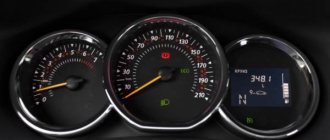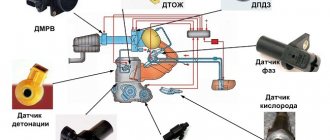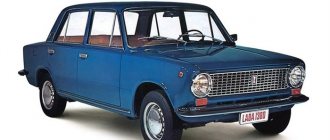The Lada Granta was released by AvtoVAZ in 2011. It replaced the Kalina model and the fuel consumption of the Lada Granta per 100 km is significantly different from its predecessor.
At the beginning of 2011, production of this Lada model began. And only at the end of the year, in December, the new Lada Granta, which belongs to class C cars, went on sale.
Classification of manufactured models
The budget front-wheel drive car Lada Granta was presented in several modifications - Standard, Norma and Luxury, each available with a sedan or liftback body.
| Engine | Consumption (highway) | Consumption (city) | Consumption (mixed cycle) |
| 1.6i | 6.1 l/100 km | 9.7 l/100 km | 7.4 l/100 km |
| 1.6i | 5.8 l/100 km | 9 l/100 km | 7 l/100 km |
| 1.6i 5-mech | 5.6 l/100 km | 8.6 l/100 km | 6.7 l/100 km |
| 1.6 5-rob | 5.2 l/100 km | 9 l/100 km | 6.6 l/100 km |
At the beginning of production, this car was produced with an 8-valve engine, then with a 16-valve engine with a total volume of 1.6 liters. Most cars have a manual transmission, and some have an automatic transmission.
It is important that the technical characteristics of the Lada Grant, fuel consumption according to the passport and according to real data make this model the best among other vases.
Models with 8-valve engine
The initial version was the Lada Granta, equipped with a 1.6-liter engine with several powers: 82 hp, 87 hp. and 90 horsepower. This model has a manual transmission and an 8-valve engine.
Other technical characteristics include front-wheel drive and a gasoline engine with multipoint injection. The car's maximum speed is 169 km/h and it can accelerate to 100 km in 12 seconds.
Grants Features with automatic transmission
When designing a car with AvtoVAZ, the automatic transmission did not reinvent the wheel, but purchased a ready-made transmission from JATCO. This gearbox is widely installed on Japanese cars and is very reliable. without The manufacturer of false modesty claims a resource that exceeds the service life of the car. Time However. will show and it is now clear that it is unlikely that an imported component will be able to ruin a domestic car.
on the contrary, it will most likely benefit Lada. To adapt it, it was necessary to reduce the ground clearance by 2 cm. Moreover, due to the fact that such a car turned out to be heavier than usual, the rigidity of the body had to be increased and the suspension strengthened. In total, AvtoVAZ designers needed to install 30 new Whats.
The units are especially nice; they used a massive gear shift knob, thereby pleasing some car enthusiasts. But the indication that the mode is on is visible only on the instrument panel; additional lighting on the handle would lead to a slight increase in the transmission. prices are four-tiered. In addition, it has an off-road position for “1” and “2” for use in urban areas.
conditions there is also a button to disable overdrive. Indispensable It is on long climbs, however, fuel consumption is significantly affected. This parameter is a sore subject for all owners of Lada automatic transmission with Grant. It is also relevant for cars with classic Very. The transmission is often a subjective criterion, as it depends on many reasons.
Gasoline consumption
Fuel consumption on an 8-valve engine averages 7.4 liters in the combined cycle, 6 liters on the highway and 8.7 liters in the city.
I was pleasantly surprised by the owners of cars of this model, who tell on the forums that the real fuel consumption on an 8-valve Lada Granta with an engine power of 82 hp. slightly exceeds the norm: 9.1 liters in the city, 5.8 liters in the extra-urban cycle and about 7.6 liters during mixed driving.
The actual fuel consumption of the Lada Granta is 87 liters. With. differs from the specified standards: city driving 9 liters, mixed - 7 liters and country driving - 5.9 liters per 100 kilometers. A similar model with a 90 hp engine. consumes no more than 8.5-9 liters of fuel in the city and 5.8 liters on the highway.
In other words, these VAZ models can be called the most successful budget models of the Lada Granta car. In winter, fuel consumption increases by 2-3 liters per 100 km.
Cars with 16 valve engine
The engine configuration with 16 valves contributes to a significant increase in engine power. Such Lada Granta models have the same 1.6 liter engine with a power of 98, 106 and 120 (sport version model) horsepower and are equipped with an automatic and manual transmission.
Technical characteristics also include front-wheel drive and an engine with distributed fuel injection. The maximum acceleration speed reaches 183 km/h, and the first 100 kilometers can be reached after 10.9 seconds of driving.
Equipment
This is one of the most significant factors on which the overall fuel consumption of a car depends. In particular, we mean differences in:
- types of bodies;
- types of power units;
- electronic equipment;
- manual or automatic transmissions, etc.
For example, the sedan and liftback are each produced in three modifications. The difference lies in the power of the unit and, accordingly, their gluttony also varies. So:
- a 98-liter engine will burn 7.8 liters at normal rates;
- at 87 – 7.2;
- at 106 – 6.9.
Gasoline costs
Official data states that the fuel consumption rate of the Lada Granta on the highway is 5.6 liters, in the combined cycle no more than 6.8 liters, and in the city only 8.6 liters per 100 kilometers.
These figures apply to all engine types.
Real fuel costs range from 5 to 6.5 liters outside the city, depending on engine power. And the average gasoline consumption of the Lada Grant in the city reaches 8-10 liters per 100 km. Winter mileage increases by 3-4 liters in all types of engines.
Test lamp method
Especially sharply increased fuel consumption per 100 km can be observed in the cold season. Along with gasoline, the consumption of other fluids of systems and components (oil, etc.) also increases. For LADA Granta, gasoline consumption in a given time period can increase to 2 liters. The main reason (provided the power system is working properly) is the need to warm up the engine in frosty temperatures. Indirect factors include driving on ice and the type of tires used (studs, Velcro, etc.).
Reasons for increasing fuel consumption
Like many cars, sometimes the Granta's gas costs exceed the norm. This happens due to:
- Engine malfunctions;
- Machine overload;
- Using additional equipment - air conditioning, on-board computer, etc.
- Constant sudden acceleration and braking of the car;
- Consumption of low-quality gasoline;
- Extra costs for illuminating the road with headlights in unnecessary cases;
- Aggressive driving style of the car owner;
- Presence of congestion on city roads;
- Wear and tear of some parts of the car or the car itself.
The winter season also increases Grant's fuel consumption by 100 km. This is due to additional costs for heating the engine, tires and vehicle interior.
The world's main methods for measuring the consumption of new cars
As we wrote above, there are several methods for measuring the average fuel consumption of cars. Let's tell you more about them.
NEDC
In Europe, the most commonly used cycle is the NEDC type, which was developed about forty years ago. This causes reproaches from experts who talk about the outdatedness of the method.
NEDC Algorithm Structure
The main features can be considered that manufacturers are allowed to use a selective method for selecting a machine. We are talking about the fact that for testing we provide cars with already run-in components, special lubricants of low viscosity, as well as with the most compact tires that can be installed on a car.
In addition, if desired, testing can be carried out with the radio, heating, and so on turned off. This allows you to “select” those results that would best suit the manufacturer.
Measurements are carried out in the urban (NEDC UDC) and suburban (NEDC EUDC) cycles. The length of the "urban test" is 780 seconds, while the suburban test involves a period of time equal to 400 seconds. In the first case, the average speed will be a little over 18 kilometers, and in the second - about 62.6 kilometers per hour.
This technique is criticized for the reason that many models with an additional electric motor can travel most of this short distance without using the internal combustion engine. This becomes the source of amazing results with extremely low fuel consumption, even in sports cars.
FTP-75
But these standards no longer meet market requirements, so manufacturers are increasingly turning to the American standard FTP-75. It is considered the closest to reality, although experts talk about problems with the lack of areas where movement occurs evenly.
FTP-75 algorithm speed dependence
It is similar to the European NEDC, including an average speed of 34.1 kilometers per hour. Another advantage is that the test duration is 1874 seconds, so it is more difficult for hybrid car models to show “unrealistically low” fuel consumption figures. But what is most important is that the American version of the test obliges manufacturers to include air conditioning if it is included in the package.
As a result, fuel consumption in this test is higher than in NEDC by 10 or even 20 percent.
Japanese cycle JC08
In the case of JC08 the difference will be even greater. The fact is that in it the number of accelerations and decelerations is maximum, and there are no long sections with even speed parameters at all.
In addition, the maximum speed does not exceed 80 kilometers per hour. On one of the sections, the length of which is 8.2 kilometers, the average speed does not even reach 25 kilometers per hour.
The slowest known method for calculating average flow
Of course, we can talk about the severity of the test, but it takes into account the increased load on the streets, which is typical for the island country of Japan. In addition, drivers in most large cities around the world find themselves in such conditions. So, it is worth considering this technique as the closest to reality.
In general, there is no optimal testing method yet. The current options represent a compromise that automakers are trying to use to their advantage. Therefore, you should always try to take into account the specific technique that gave the results specified in the vehicle specifications.
Automatic gearbox
A 16-valve engine model with a power of 98 and 106 horses is equipped with an automatic transmission. Thanks to the gearbox, such models consume more fuel. The reason is that the automatic device changes gears with a delay and, accordingly, the fuel consumption of the Lada Granta automatic increases.
So, the fuel costs for a 16-valve model with a power of 98 hp. are 6 liters on the highway and 9 liters on city roads.
Engine with 106 hp. consumes 7 liters on the highway and 10-11 liters outside the city.
Mixed driving consumes about 8 liters per 100 kilometers. Winter driving increases fuel costs for the Lada Grant automatic transmission of both engines by an average of 2 liters.
Official data (l/100 km)
| Engine | Consumption (city) | Consumption (highway) | Flow (mixed) |
| 1.6 MT 82 hp (Mechanics) | 9.7 | 6.1 | 7.4 |
| 1.6 MT 87 hp (Mechanics) | 9.0 | 5.8 | 7.0 |
| 1.6 AT 87 hp (machine) | 10.4 | 6.1 | 7,7 |
| 1.6 MT 98 hp (Mechanics) | 8.8 | 5.6 | 6.8 |
| 1.6 AT 98 hp (machine) | 9.9 | 6.1 | 7.6 |
| 1.6 MT 106 hp (Mechanics) | 8.6 | 5.6 | 6.7 |
| 1.6 AMT 106 hp (robot) | 9.0 | 5.2 | 6.6 |
The basis of the car is the engine, the volume of which is 1.6 liters. Its 8-valve version has the lowest power, capable of producing 87 hp. It is paired with either a four-speed automatic transmission or a manual transmission with five operating modes. Such an engine consumes up to 7 liters of fuel. The version with 16 valves already produces as much as 106 horsepower and can have exactly the same gearboxes. Fuel consumption per 100 km for such a unit varies from 6.6 to 7.1 liters. There is a special version, which is labeled Sport. Here the engine already produces 116 horsepower, paired only with a five-speed manual transmission. Consumption here is already higher and amounts to 10.7 liters in the city and almost 7 liters on the highway.
Sedan and liftback body
The Lada Granta sedan went on sale in 2011 and immediately became a popular car model. The reason for this was the massive purchases of this particular car: two years after its release, every 15 purchased car was a Lada Granta sedan. Of the three known trim levels - Standard, Normal and Luxury, the most affordable option is the standard. The engine capacity is 1.6 liters and the power is 82 hp. With. makes this 4-door model not only a budget, but also a practical economy class car. And the average gasoline consumption of the Lada Granta sedan is 7.5 liters per 100 kilometers.
Before the release of the new Lada model, many became interested in how much it would change. As a result, the technical characteristics of the liftback are not very different from the sedan. This car entered the market in 2014. The main changes are visible in the exterior of the car and in the 5-door configuration. Other functional devices remained the same or were improved. The lack of changes can be seen on the car configuration, which was transferred from the Grant sedan. Fuel consumption in such cars is slightly higher, as engine power has increased.
Owner reviews
“I initially didn’t really like the appearance of the new VAZ model, but when the liftback version appeared, I seriously thought about buying it. After saving a little, I bought it. I can say that for a Russian car, everything here is not even bad. The interior is rather rustic, but there is a lot of stuff even in the basic version. Over several years of use there was not even a hint of anything breaking. Due to its small size, the car is well suited for city use. But I also enjoy driving on the highway. Here the VAZ engine performs well, allowing you to quickly gain the speed necessary for a comfortable ride. It's a pity that the car has high consumption. The version with automatic transmission consumes up to 12 liters in the city, and on the highway it reaches 8,” writes Grigory from Podolsk.
“When I was choosing a car, I paid attention to many parameters. The main one was fuel consumption. According to the reviews that I read a bunch, Granta’s was not great. And so, in 2014, I bought it. What’s attractive is that it was made with our roads in mind. Although the suspension is stiff, you don’t feel any bumps or potholes. But in the cabin everything is not so rosy. It itself is made so-so, it constantly sticks together and rattles, and the sound insulation suffers, which is why many sounds from the street can be heard. But the cost of gasoline really turned out to be minimal. My consumption rate is 8 liters, and in winter the consumption does not exceed 10 liters,” says Victor from Lipetsk.
And this is Ilya’s review from Tolyatti:
“I’ve always driven foreign cars, but after mine began to break down often, I started thinking about buying a new car. I noticed a new product from the domestic automobile industry - the Grant liftback. During the first year of driving I did not experience any problems at all. Everything was perfect both technically and comfort-wise. But recently the dashboard began to creak, and the sound insulation also became unusable. This is very annoying and does not allow you to relax on long trips. The solution to the problem is listening to music at medium volume. Otherwise, everything is good so far. I like the dynamic performance, and my wife is happy with the trunk, which can accommodate all her many purchases. In terms of consumption, I will say that it is acceptable and does not exceed 10 liters in the city.”
“The first thing I want to say after using the car for a year is that the car is ideal for our roads. It's set high, the suspension is stiff with decent travel, so you don't feel any potholes, of which we have a lot. Nothing has broken yet, the service was only to replace consumables. He looks great, always loved compact cars. The feel of the interior is a little worse; they clearly saved on the quality of the assembly and materials. But there is a lot of free space, which is good news. I drive mostly around the city and rarely go outside, so it takes a lot of fuel. The norm for me is 10 liters,” notes Vitaly from Omsk.
And this is how Philip from Rostov speaks about his choice:
“I don’t regret that I bought this particular car at the time, although there were many options. He has never let me down yet. Perfect for use both for city needs and for long trips. Good cross-country ability and unpretentiousness allow you to drive even where there are no roads at all. The engine pulls vigorously, speed and acceleration are quite enough. It consumes 1 liter of fuel in the city and 8 on the highway.”
“During the time that I have been using the car, I have realized that if you look after it and care for it properly, it will last for many years. So, in 3 years of driving, I have never visited a repair shop for serious reasons. I made all replacements of consumables in a timely manner. The only thing I don't like about it is the interior quality. At high speed it will rattle and rattle a lot. Otherwise, everything is fine and I’m definitely not going to change the car,” writes Stanislav from St. Petersburg.
The Lada Granta was released by AvtoVAZ in 2011. It replaced the Kalina model and the fuel consumption of the Lada Granta per 100 km is significantly different from its predecessor.
Options for reducing fuel consumption
The fuel consumption of the engine directly depends on the above factors that affect the increase in gasoline costs. To reduce fuel consumption, you need to:
- check all engine systems for serviceability;
- monitor the electronic system;
- detect injector problems in time;
- regulate fuel system pressure;
- clean air filters in a timely manner;
- turn off headlights if they are not needed;
- drive the car smoothly, without jerking.
The transmission plays an important role in fuel consumption. Owners of a VAZ with a manual transmission have lower costs than drivers of a Lada Granta automatic. Therefore, when choosing a car of this model, you need to take into account all the factors that influence moderate fuel consumption.
Lada Granta cars are one of the few that have a powerful engine and relatively low fuel consumption. This is one of the main advantages in a series of budget cars.
Driving style
Fuel consumption also largely depends on it. Fans of speed and spectacular starts with sudden stops spend more fuel than calm car owners.
Moreover, when the driver constantly starts with a cold engine, the amount of gasoline burned usually increases by approximately 12 percent.
As previously noted, the operation of various electronic systems, including air conditioning, also requires fuel. The more gadgets and gadgets installed on a car, the more difficult it is to save gas.
Only one air conditioner can “eat” an additional 15 percent of the total volume.










